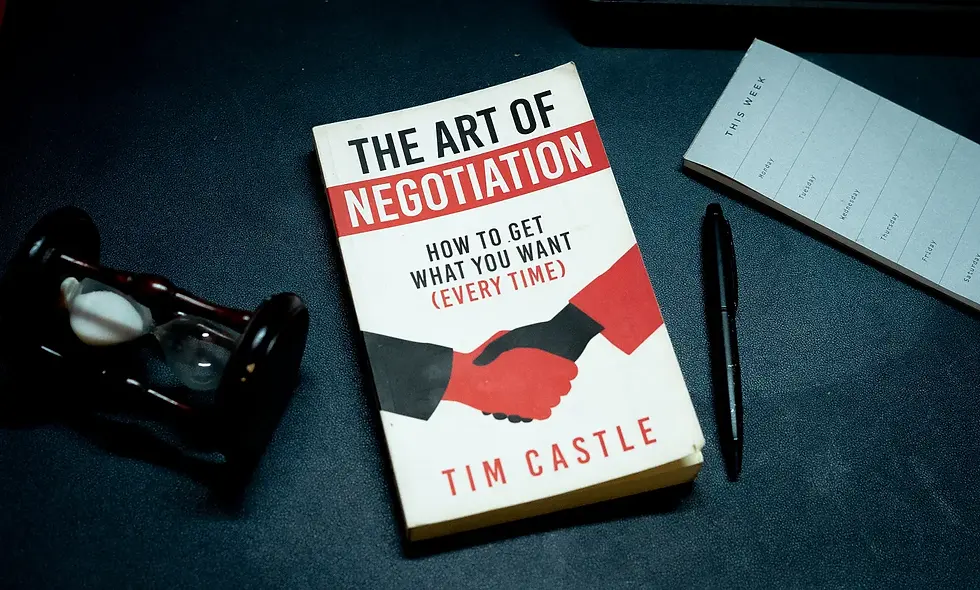Understanding 6 Key Non-Verbal Signals That Shape Your Negotiation Destiny
- chief438
- Mar 3, 2024
- 3 min read
Updated: Mar 29, 2024
You’re in a high-stakes negotiation, facing someone tough. Words fly, but what really matters are the quiet cues. The way you stand, how you look, even your handshake — these silent signals can change everything in negotiation. Learning these signals is like having a special skill. Let’s explore the secrets of body language and uncover six key signals that can make or break your negotiation success.

1. Body Language Speaks Volumes: It’s said that actions speak louder than words, and nowhere is this truer than in negotiation settings. Your body language — posture, gestures, facial expressions — conveys confidence, trustworthiness, and authority. Maintaining an open posture with relaxed shoulders and uncrossed arms signals approachability and receptivity. Conversely, crossed arms and fidgeting can indicate defensiveness or discomfort, potentially undermining your negotiation position.
2. The Power of Eye Contact: Eye contact is a potent tool in negotiation dynamics. It fosters connection, communicates sincerity, and establishes rapport. When engaging in negotiations, maintaining steady eye contact demonstrates confidence and assertiveness. However, be mindful of cultural differences, as eye contact norms may vary across regions. In some cultures, prolonged eye contact may be perceived as confrontational, while in others, it’s a sign of respect and attentiveness.
3. Mirroring and Matching: Mirroring and matching involve subtly mimicking the body language, gestures, and speech patterns of your negotiation counterpart. This mirroring technique builds rapport and creates a sense of harmony, fostering a conducive environment for agreement. However, it’s essential to employ mirroring tactfully and authentically, as overt imitation can come across as insincere or manipulative.

4. The Firmness of Handshakes: The handshake is often the first physical interaction in a negotiation encounter, and its impact should not be underestimated. A firm handshake exudes confidence and professionalism, instilling trust and credibility in your negotiation counterpart. Conversely, a weak or limp handshake may convey uncertainty or lack of conviction, potentially weakening your negotiation stance from the outset.
5. Voice Tone and Pace: Your voice tone and pace are potent non-verbal cues that can influence negotiation dynamics. Speaking with a calm, steady tone conveys assurance and composure, while erratic or nervous speech patterns may betray insecurity or apprehension. Additionally, varying your vocal pace can emphasize key points, maintain engagement, and command attention during negotiations.
6. Space and Proximity: The spatial dynamics of a negotiation setting play a significant role in shaping interactions and power dynamics. Pay attention to proxemics — the study of personal space — and be mindful of how you navigate physical proximity during negotiations. Invading personal space can be perceived as aggressive or intrusive while maintaining an appropriate distance fosters comfort and respect.
Mastering these key non-verbal signals requires self-awareness, adaptability, and keen observation. By honing your ability to interpret and leverage non-verbal cues, you can navigate negotiations with finesse and confidence, ultimately shaping your negotiation destiny.
While verbal communication is undoubtedly crucial in negotiations, it’s the non-verbal signals that often leave a lasting impression and sway the outcome. From body language to vocal tone, every gesture and intonation carries significance in the negotiation arena. By understanding and harnessing these non-verbal cues, you can elevate your negotiation skills and chart a path towards success. So, the next time you find yourself at the negotiating table, remember to listen not just with your ears but with your eyes and instincts, for therein lies the true language of negotiation mastery.

Are you ready to unlock the secrets of non-verbal communication and elevate your negotiation game? Dive deeper into the art of negotiation with my book, “The Art of Negotiation: How to Get What You Want (Every Time).” Packed with practical tips, real-world examples, and actionable strategies, this essential guide will empower you to negotiate with confidence and finesse. Don’t just negotiate — master the art of negotiation and seize control of your destiny today!







Comments